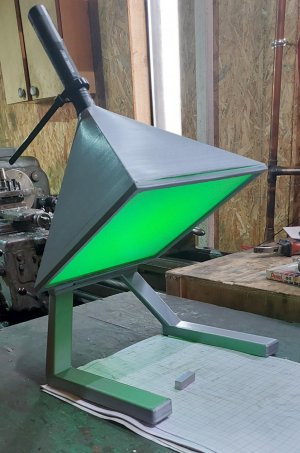Ok, I've settled on this for now:

I had an old broken LCD TV I've used the diffuser of. This is a 3d printed enclosure With a friction hinge so it can be set ag any angle (within balance) and it'll stay as set. For switching on the laser I use a zip tie that is not quite tight. One can turn it to switch on, turn the opposite way to turn off.
I've also planned in a way to put a "reticle" printed on transparency. There could be a ruler printed on it to make estimating fringe pattern thickness easier.
There is a small square of the diffuser material right in front of the laser aperture, and the big rectangular piece is 4.5in away. I found it to be the least distance to get even Illumination of a 8*8inch area.
Speaking of that LCD TV. I didn't know how interesting these are built... The light are rows of widely spaced (5inx5in) white LEDs each with an integrated "thing" that directs the light. There is really reflective white foil behind the LEDs. In from there is about an inch and a half of space, then there is a white plastic diffuser that would make a marvellous filming light. Its made of plastic with one side more smooth(front) and back more textured. Then in front of that plastic there is a very weird foil fresnel-like lens. It is definitely fresnel (due to the way it diffract white light), but it's elements are too small to see. Also it seems to be a cylindrical/horizontal (rather than spherical) lens. A laser pointer shone through results in horizontal line on the wall. Then there is another foil diffuser that makes the light look "soft and blurry". Rather than crisp and sharp. A laser pointer shobe through it results in a square outline with highlighted corners being projected on the wall. The square is the same size regardless of distance! (few inch). Then there is the display unit. The tech in those, TVs sure is interesting. I hope I'll find some use for the other components.
BTW, I've found a proper name for this "thing". It's called a Fizeau interferometer. If you search this term you'll find more information.
I also found a set of two big 5in diameter collimating lenses (about 8in focal length). These were a part of a black&white traditional photography developing setup I had many years, ago. So I guess I could try making that Fizeau interferometer, but I'm happy with my 3d printed diffuser for now so I'm planning to use it.

I had an old broken LCD TV I've used the diffuser of. This is a 3d printed enclosure With a friction hinge so it can be set ag any angle (within balance) and it'll stay as set. For switching on the laser I use a zip tie that is not quite tight. One can turn it to switch on, turn the opposite way to turn off.
I've also planned in a way to put a "reticle" printed on transparency. There could be a ruler printed on it to make estimating fringe pattern thickness easier.
There is a small square of the diffuser material right in front of the laser aperture, and the big rectangular piece is 4.5in away. I found it to be the least distance to get even Illumination of a 8*8inch area.
Speaking of that LCD TV. I didn't know how interesting these are built... The light are rows of widely spaced (5inx5in) white LEDs each with an integrated "thing" that directs the light. There is really reflective white foil behind the LEDs. In from there is about an inch and a half of space, then there is a white plastic diffuser that would make a marvellous filming light. Its made of plastic with one side more smooth(front) and back more textured. Then in front of that plastic there is a very weird foil fresnel-like lens. It is definitely fresnel (due to the way it diffract white light), but it's elements are too small to see. Also it seems to be a cylindrical/horizontal (rather than spherical) lens. A laser pointer shone through results in horizontal line on the wall. Then there is another foil diffuser that makes the light look "soft and blurry". Rather than crisp and sharp. A laser pointer shobe through it results in a square outline with highlighted corners being projected on the wall. The square is the same size regardless of distance! (few inch). Then there is the display unit. The tech in those, TVs sure is interesting. I hope I'll find some use for the other components.
I think I get it.
Not just a light field required, for near-contact interference, but two beams combining
distant from two spaced-apart surfaces...
It has to be a phase reference because of parallax.
Big lens is one way, big mirror is probably better.
BTW, I've found a proper name for this "thing". It's called a Fizeau interferometer. If you search this term you'll find more information.
I also found a set of two big 5in diameter collimating lenses (about 8in focal length). These were a part of a black&white traditional photography developing setup I had many years, ago. So I guess I could try making that Fizeau interferometer, but I'm happy with my 3d printed diffuser for now so I'm planning to use it.
Last edited:

